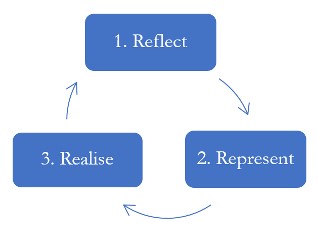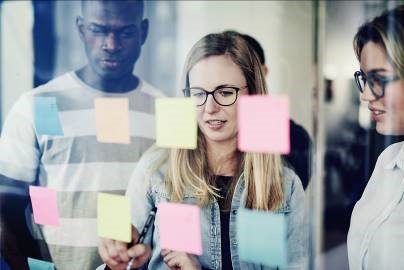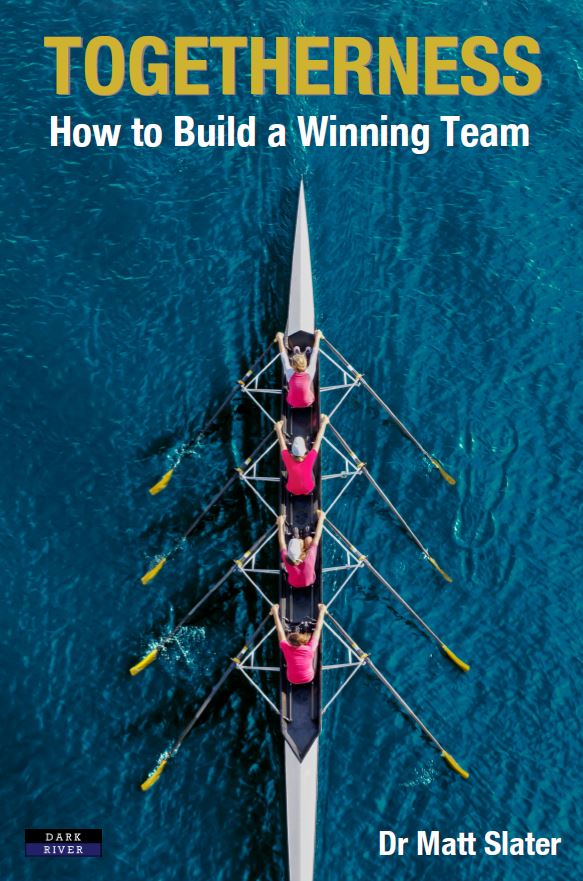An excerpt from:

Chapter 2: Introducing the 3Rs. Reflect, Represent, Realise
The 3R model
So far, we have learnt about the importance of togetherness for high performance and how this is underpinned by scientific evidence and powerful stories of high-performing sports teams.
Now, we turn our attention to how you can develop togetherness in your team. We shall think even more practically about how this can be achieved in a simple and clear way. Now, we introduce the 3R model which orientates the reminder of our journey in this book.
The 3R model involves three phases – Reflect, Represent, and Realise.[10] In this chapter, we get to know the model before subsequent chapters delve into each phase in more detail, including practical activities for you to complete with your team.
The vision of the 3R model is simple – to develop togetherness.
It achieves this by providing a framework for you to turn to your team and the context within which you lead. Figure 3 outlines the progression of the 3R model and how each stage ultimately feeds into the next.
Figure 3: The 3R model

1. Reflect
Following competition – on the journey home perhaps – sports coaches reflect on the day. They consider the performance of their team, the outcome (win, lose, draw), but they also reflect on their own approach and behaviour. They ask questions such as:
– What did I do well today?
– Where did I make a positive impact today?
– What could I have done better today?
– How did my team talks land with the players and staff today?
– How can I have more influence on my players next week?
This act of self-reflection is an important process that all individuals complete – plus, it’s universally encouraged. It can help individuals analyse their own strengths with a view to applying and maximising them once again in the future. It can also help individuals analyse their own limitations with a view to improving their skills for the future.
In order to unlock the togetherness of your team, reflection takes on a different form. Here, you are challenged to reflect on, and with, your team to understand “who we are” and “who can we become”?

[above] The Reflect phase aims to capture the history, culture, and dynamics of the team: What are we about? What are our values? What is unique about us?
You are seeking to understand the history, culture, and dynamics of the team. You observe, listen, and ask questions to truly understand the membership of the group and what members believe to be important to “us”.
Objectives of the Reflect phase:
– Understand the group memberships that players on your team have
– Understand what values players associate with the team, and the vision they have for the team
– Understand the team’s unique characteristics
– Understand the team’s past trials and tribulations, and triumphs
2. Represent
The Represent phase involves role modelling team values, and championing your team’s interests. You put the team before yourself, where your focus is on the team’s interest rather than your own personal interest.
The importance of the Reflect phase is clear here, as you are unable to represent “our” values and lead by example if you have not understood the team in the first place (through Reflection).
Also, understanding the history and culture of the team provides opportunities for you to fully and authentically understand what we need to do as a team to develop. Here too, you develop your ability to propose new ideas that will be of benefit to “us”. You outline proposals and ideas that connect with “our” shared values and ambitions.
Objectives of the Represent phase:
– Develop shared values and a shared vision
– Develop behaviours aligned with the team’s shared values
– Put the team first (e.g., when making decisions)
– Put team interest/gain above personal interest/gain
3. Realise
Following on from the Represent phase, Realise involves facilitating opportunities and activities so that the team can live out “our” shared values and make progress toward/achieve the collective vision.
You work to ensure that we make our ambitions a reality. You organise events and activities that align with the shared values and vision – the tailored training programme, staff/player recruitment, leadership allocation/development, schedules, planning, events, activities, and so on. You make progress toward and/or achieve what we value as a group.
As we saw in Chapter 1, the distinct and special values we have as a team may be multiple and diverse. It is the precise and unique values that “we” share that need to be translated into reality. This is where the development of togetherness, built upon the Reflect and Represent phases, can be realised.
Objectives of the Realise phase:
– Live out team values in reality
– Behave in-line with the team’s shared values
– Make progress toward/achieve the collective vision
– Achieve togetherness
*

